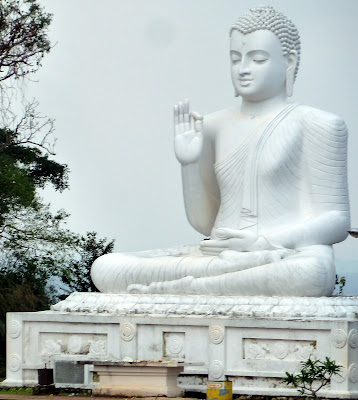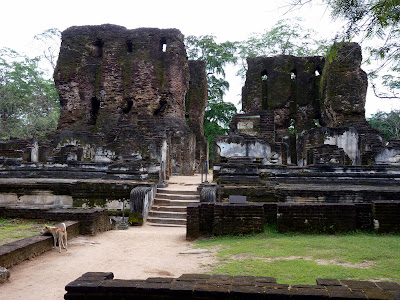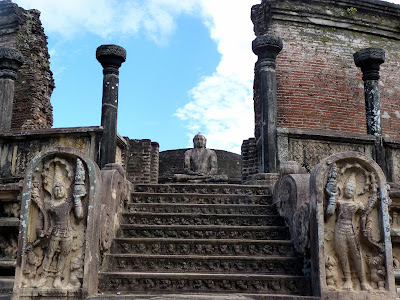 |
| Contemplating the massive Jetavanarama Dagoba at Anuradhapura |
Our journey through the "Ancient Cities" region of Sri Lanka continued in the city of Anuradhapura, which served as the Sinhalese capital from the 4th century BCE to about the year 1000. In its heyday, which lasted from the 3rd century BCE to the around the 4th century CE, the Sinhalese kings undertook vast building projects and made Anuradhapura into a great city. But Indian invaders were a constant threat, and over time the city's success became its undoing, as the excellent road network built to serve the city made the invasions increasingly difficult to repel.
 |
| Jeremy at the rock temple in Anuradhapura |
Today, the old city teems with ancient Buddhist monuments, including one of the oldest trees in the world, a sacred bodhi tree that has grown over the last two millenniums from a cutting taken from the very tree in India under which the Buddha attained enlightenment. The area around the tree was decorated with colorful prayer flags and buzzing with pilgrims making offerings. Another memorable monument was the massive dome of the Jetavanarama Dagoba, built in the 3rd century CE. At the time of its construction, it was the third tallest structure in the world, surpassed only by the two tallest Egyptian pyramids. An English guidebook of the early 1900s calculated that the Jetavanarama Dagoba contained enough bricks to build a 3-meter high wall from London to Edinburgh. Among other things, Anadhapura's collection of ancient monuments also includes a 4th century seated Buddha that is considered one of the finest Buddha statues in Sri Lanka (which is quite a feat, given the vast number of Buddha statues in the country); the 3rd century BCE Thuparama Dagoba, the first Buddhist temple in Sri Lanka and one of the oldest standing Buddhist monuments in the world; and a fascinating rock temple that also dates from the 3rd century BCE.
 |
| Mihintale, where the Sri Lankan King converted to Buddhism |
Close to Anuradhapura is Mihintale, a sleepy town (with terrible roads) where the Sinhalese King Devanampiya Tissa converted to Buddhism in the year 247 BCE. The sacred site that marks the spot is perched atop a steep hill, affording excellent views of the surrounding rural countryside. You reach the top by a series of long, dramatic, tree-lined staircases. It's an atmospheric and attractive place, with an interesting mix of ancient ruins and active places of worship. Anuradhapura and Pollonaruwa get more attention in the guidebooks and attract many more tourists, but Mihintale is equally - if not more - impressive.
 |
| Buddha statue at Pollonaruwa |
Pollonaruwa was the next stop on the Bruner Family Journey Sri Lankan Ancient Cities 2011 Tour. In around the year 1000, the Chola empire from southern India conquered Anuradhapura and they made Pollonaruwa their Sri Lankan capital. When the Sinhalese drove the Cholas off the island in the year 1070, they kept Pollonaruwa as their capital. The city reached its apex in the 12th century under King Parakramabahu I, who instituted a series of monumental building projects. Unfortunately, the king's successor bankrupted the kingdom in trying to match these achievements, and like Anuradhapura, Pollonaruwa ultimately succumbed to Indian invaders. The city was subsequently abandoned and left to the weeds.
 |
| Scenic lake at Pollonaruwa |
One of the highlights of the old city is a dense collection of ancient Buddhist monuments known as the Quadrangle, which includes an elegant circular shrine, a tall stepped building that looks like a Central American pyramid, and a beautiful 800-year old temple that still has its roof intact. Another highlight is a group of four Buddha statues, each carved from a single piece of granite, that is believed the represent the high point of Sinhalese rock carving. Other attractions include a 13th century Hindu temple; an extensive royal palace; a tall, narrow corridor that dramatically leads to a giant headless Buddha; several impressive domed dagobas; a number of very pretty pools, including an unusual one shaped like a lotus leaf; and a large water reservoir built in the 12th century that is now a scenic lake.
 |
| Monkey mom with monkey baby |
 |
| The circular temple |
 |
| Dagoba #1 |
 |
| Dagoba #2 |
 |
| Dagoba #3 |
 |
| Tall, narrow corridor leading to giant headless Buddha |
 |
| The height of stone carving at Pollonaruwa |
 |
| The "Lotus Pool" |
 |
| The "Overgrown Pool With Monkey" |
 |
| More form Aukana |
 |
| At the forest monastery at Ritigala |
 |
| Ancient walkway at Ritigala used by monks for meditation |
 |
| Shot from the road near Ritigala |
 |
| More from the road near Ritigala |
 |
| Roadside Buddha |





























































